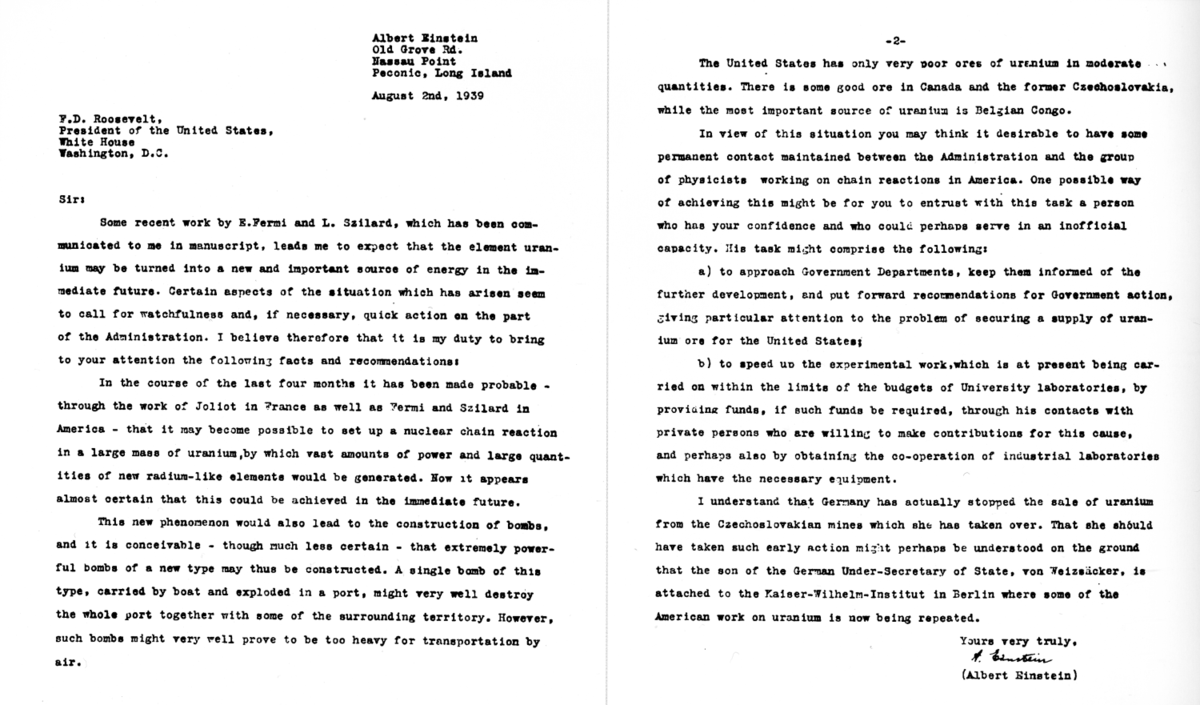On August 2, 1939, Albert Einstein wrote a letter to President Franklin D. Roosevelt to notify him of recent developments in nuclear physics that suggested the element uranium could be turned into a new and important source of energy. Einstein warned that the energy could be used to create extremely powerful bombs that could destroy a target and its surroundings. Einstein recommended that Roosevelt maintain, “permanent contact… between the Administration and the group of physicists working on chain reactions in America.”
Two months later, the letter was personally delivered to President Roosevelt. In response to the letter Roosevelt approved the establishment of the Advisory Committee on Uranium to examine that status of uranium research in the United States and recommend how the government could support further research.
General George C. Marshall did not become involved with the development of atomic weapons until October 1941 when Roosevelt appointed him to the Top Policy Group. The group was responsible for overseeing the atomic program of the United States and Marshall was the only military representative in the group.
The army’s experience managing large construction projects left Marshall responsible for getting the project started and keeping in running. In an interview with his biographer, Forrest Pogue, Marshall stated:
I had to get the money and I directed all these preliminary operations and the construction of the affair. Not that I knew anything about the technique at all. But to get things done-to amass the money and the men and everything else of that sort. I was rather amused at myself because as time wore on, these long statements that would come, that were filled with complicated procedures necessary in these matters and the technical terms involved – I spent so much time with the Encyclopedia Britannica or the dictionary trying to interpret what they said, that I finally just gave it up, deciding that I never would quite understand it all.
In 1942, Marshall appointed General Leslie Groves, who had been in charge of the construction of the Pentagon, to manage the top-secret project that became known as the Manhattan Project. The cost of the project was enormous, which meant that Marshall and Secretary of War Henry L. Stimson repeatedly appeared before Congress to ask for additional funding even though they could not explain how the money was being used. Marshall recalled that:
It was very difficult to do because he (Stimson) couldn’t explain what it was except that it was a great secret and he could not explain the secret. But they would have to take his word for it and my word for it that it was of vital importance that we get this additional money and that it was equally vital importance that not a word be breathed of what the thing really was.
Marshall was attending the Potsdam Conference in Germany when the first atomic bomb was successfully detonated in the desert of New Mexico on July 16, 1945. On the morning of July 17, President Truman notified Marshall along with the head of the Army Air Forces General Henry H. Arnold of the successful test in a private meeting. Although Marshall was not directly involved in much of the Manhattan Project, he played a critical role in its success.

